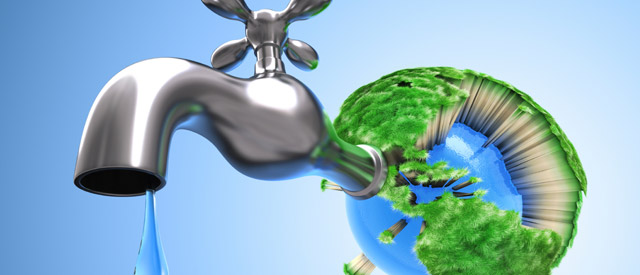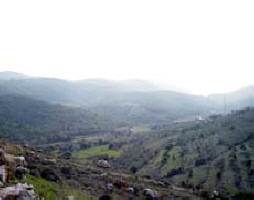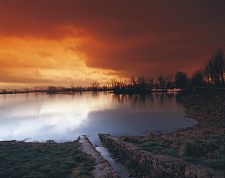-
Sobrino, J.A., Romaguera, M., 2004, Land Surface Temperature Retrieval from MSG1-SEVIRI Data, Remote Sensing of Environment, 92, 247-254.
-
Sobrino, J. A., Zaragoza-Ivorra, M.M., Sanz, M. J. and Chordá, J. V., 2004, Aplicación de la teledetección al estudio de los flujos de carbono. Revista Española de Física, vol. 18, No. 4, pp. 28-34.
-
Romaguera, M., Sobrino, J. A., 2004, Determinación de la temperatura de la superficie terrestre a partir de datos MSG1/SEVIRI. Revista Española de Teledetección, vol. 22, pp. 25-31.
-
J. Wen, Z. Su, Y. Ma, 2004, Reconstruction of a Cloud-free Vegetation Index Time Series for the Tibetan Plateau, Mountain Research and Development, 24(4), 348–353.
-
Jiménez-Muñoz, J. C., and Sobrino, J. A., 2005, Atmospheric water vapor content retrieval from visible and thermal data in the framework of the DAISEX campaigns. International Journal of Remote Sensing, vol. 26, No., 15, pp. 3163-3180.
-
Gómez, M., Olioso, A., Sobrino, J. A., Jacob, J., 2005, Retrieval of evapotranspiration over the Alpilles/ReSeDA experimental site using airborne POLDER sensor and thermal camera. Remote Sensing of Environment, 96, pp. 399-408.
-
Sobrino, J. A., and Jiménez-Muñoz, J. C., 2005, Land surface temperature from thermal infrared data: An assessment in the context of the Surface Processes and Ecosystem Changes Through Response Analysis (SPECTRA) mission. Journal of Geophysical Research, vol. 110, D161103, doi:10.1029/2004JD005588.
-
Sobrino, J. A., Gómez, M., Jiménez-Muñoz, J. C., Olioso, A., Chehbouni, G., 2005. A simple algorithm to estimate evapotranspiration from DAIS data: Application to the DAISEX campaigns. Journal of Hydrology, vol. 315, pp. 117-125.
-
Sobrino, J. A., Jiménez-Muñoz, J. C., and Verhoef, W., 2005. Canopy directional emissivity: Comparison between models, Remote Sensing of Environment, 99: 304-314.
-
Romaguera, M., Sobrino, J.A and Olesen F.-S., 2005. Estimation of sea surface temperature from SEVIRI data: algorithms test and comparison with AVHRR products. International Journal of Remote Sensing. (in press).
-
Jiménez-Muñoz, J. C., and Sobrino, J. A., 2006. Error sources on the land surface temperature retrieved from thermal infrared single channel remote sensing data, International Journal of Remote Sensing (in press).
-
E. J. Noyes, G. Sòria, J. A. Sobrino, J. J. Remedios, D. T. Llewellyn-Jones and G. K. Corlett, 2006. AATSR land surface temperature product algorithm verification over a WATERMED site. Advances in Space Research (in press)
-
Sòria, G. and Sobrino, J. A., 2006. ENVISAT/AATSR derived Land Surface Temperature over a heterogeneous region, Remote Sensing of Environment (in review).
-
Romaguera, M. and Sobrino, J. A., 2006. Surface Temperature and Water Vapour Estimation from Meteosat8/SEVIRI Data: Algorithms and Validation. Remote Sensing of Environment (in review).
-
European Geophysical Society Symposium, EGS-AGU-EUG (2004). Jia, L., Liu, Q., Su, B and Menenti, M., Inversion of linear mixing model to retrieve component temperatures
-
European Geophysical Society Symposium, EGS-AGU-EUG (2004). Jin, X. M., Wan, L., Su, Z., Research on Evaporation of Taiyuan Basin Area by Using Remote Sensing
-
El Kharraz, J., Sobrino, J. A., Morales, L., Jiménez-Muñoz, J.C., Sòria, G., Gómez, M., Romaguera, M. and Zaragoza-Ivorra, M.M., Land cover dynamic in the Mediterranean Basin using Renalysis and PAL Data, European Geosciences Union (EGU), Geophysical Research Abstracts, vol. 6, 04021, Nice (France), 25-30 April 2004.
-
J. F. Moreno, L. Alonso, G. Fernández, J. C. Fortea, S. Gandía, L. Guanter, J. C. García, J. M. Martí, J. Melia, F. Camacho de Coca, J. García-Haro, B. Martínez, A. Verger, J. A. Sobrino, J. Cuenca, J. C. Jiménez-Muñoz, G. Sòria, M. Romaguera, M. M. Zaragoza-Ivorra, J. A. Martínez-Lozano, M. P. Utrillas, V. Estellés, J. L. Gómez, J. Calpe-Maravilla, J. Vila-Frances, L. Faus-Ferrer, A. Calera-Belmonte, J. González Piqueras, A. Moratalla, A. Cuesta, e. Rubio, F.J. Montero Riquelme, A. Brasa ramos, F. Montero-García, A. Cruz, H. López Coroles, R. López Urrea, M. Pujadas, F. Molero, A. Herranz, M. Habermeyer, M. Bachean, S. Holzwarth, A. Mueller, F. Baret, D. Beal, G. d’Urso, R. Giorgiogaggia, U. Lazzaro, R. Boussema, R. Abdelfattah, H. Bouchnak, J.-L. Roujean, O. Samain, R. Bianchi, M. Davidson, The SPECTRA Barrax Campaign (SPARC): Overview and first results from CHRIS data, Proceedings of the 2nd CHRIS/Proba Workshop, ESA/ESRIN, Frascati (Italy), 28-30 Abril 2004.
-
Romaguera, M., Sobrino, J. A., Sòria, G., Zaragoza, M.M., Cuenca, J., Gómez, M., Jimánez-Muñoz, J. C., and Galdón-Ruiz, A., 2004, Land surface temperature derived from the MSG-SERIVI data, Proceedings of the 2nd MSG RAO Workshop, Salzburg, Austria, ESA SP-582, November 2004.
-
Sória, G., Cuenca, J., Sobrino, J. A., Jiménez-Muñoz, J. C., Gómez, M., Romaguera, M., Zaragoza, M. M., Galdón Ruiz, A., Surface temperature estimation from AATSR data, ENVISAT Symposium, Salzburg (Austria), 6 - 10 September 2004.
-
Su, Z., Jia, L., Jin, X., Elbers, J., Gieske, A.S.M., Timmermans, W.J., van der Kwast, H., Olioso, A., Sobrino, J.A., Moreno, J., Nerry, F., Sabol, D. (2004) Land-atmosphere exchanges of water and energy in space and time over a heterogeneous land surface. In: Proceedings of the 2nd international CAHMDA workshop on : the terrestrial water cycle : modelling and data assimilation across catchment scales, October 25-27, Princeton. / ed. by A.J. Teuling, H. Leijnse, P.A. Troch, J. Sheffield and E.F. Wood. pp. 129-130.
-
Jiménez-Muñoz, J. C., Sobrino, J. A., Guanter, L., Moreno, J., Plaza, A., and Martínez, P., 2005. Fractional Vegetation Cover Estimation from PROBA/CHRIS Data: Methods, Analysis of Angular Effects and Application to the Land Surface Emissivity Retrieval, 3rd ESA CHRIS/Proba Workshop, ESRIN, Frascati, Italy
-
Julien, Y., Sobrino, J.A., Zaragoza, M., Cuenca, J., Gómez, M., Jiménez-Muñoz, J. C., Romaguera, M., Shen, Q., Sòria, G., 2005, Global vegetation monitoring through multitemporal analysis of pathfinder AVHRR land database, SPIE European International Symposium Remote Sensing, 19-22 September (Bruges, Belgium), Proc. of SPIE, vol. 5976, 59761F, 2005. 0277-786X/$15. doi: 10.1117/12.626809.
-
Romaguera, M., Sobrino, J.A., Gieske, A., Su, Z. B., Sòria, G., 2006, Surface temperature estimation from Meteosat8/SEVIRI data: Algorithms and Validation. The 9th International Symposium on Physical Measurements and Signatures in Remote Sensing, ISPMSRS 2005 Conference Proceedings (Part One), pp. 100-103, Beijing, 17-19 October 2005, China.
-
Julien, Y., Sobrino, J. A., Zaragoza, M., Cuenca, J., Gómez, M., Jiménez-Muñoz, J. C., Romaguera, M., Shen, Q., Sòria, G., 2005, Global monitoring of land cover through PAL and Reanalysis Data. The 9th International Symposium on Physical Measurements and Signatures in Remote Sensing, ISPMSRS 2005 Conference Proceedings (Part One), pp. 423-425, Beijing, 17-19 October 2005, China.
-
Gómez, M., Sobrino, J. A., Jiménez-Muñoz, J. C., Olioso, A., 2005. Retrieval of daily evapotranspiration from remote sensing images of high and low spatial resolution. application to the Iberian peninsula. Proceeding Earth Observation Conference, Napoli, Italy, 10-11 Nov.
-
Sobrino, J. A., M. M. Zaragoza-Ivorra, Y. Julien, J. C. Jiménez-Muñoz, Gómez, M., M. Romaguera,
J. Cuenca, J. El Kharraz, M. Atitar, G. Sòria, B. Su, A. Gieske, L. Jia, Z. L. Li, F. Nerry, W. Verhoef, 2006. Exploitation of angular effects in land surface observations from satellites-EAGLE. Proceeding RAQRS""II, Torrent (Valencia), Spain, 25-29 Sep.
 GMES EAGLE- Exploitation of Angular effects in land surface observations from satellites
GMES EAGLE- Exploitation of Angular effects in land surface observations from satellites you are not logged in
you are not logged in





